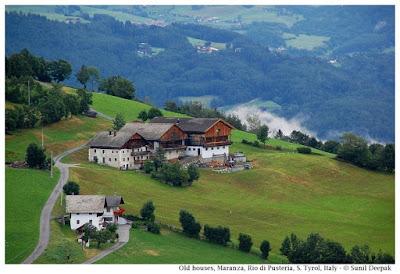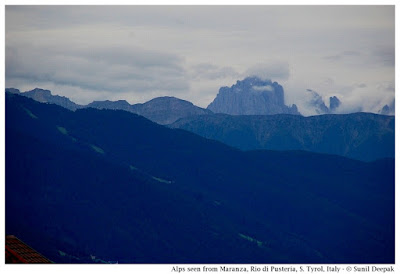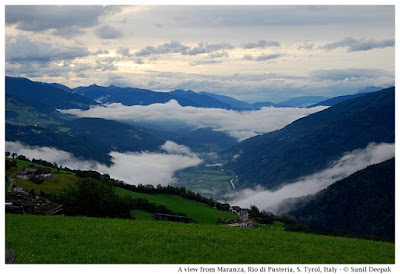The First World War was fought between the Austrian-Hungarian empire on the east and the rest of the Europe (and USA) on the west, between 1914-1918.
The tiny town of Schio in north-east part of Italy, where I live, is a part of the Vicentino area around the historical town of Vicenza, and is marked by the little Dolomite mountains of the Alps. Some of the most furious battles of that war were fought in these mountains.
There are three major war monument-cemeteries (known as Sacrario) on these mountains - on Pasubio mountain, on the Altopiano of Asiago and on the Grappa mountain. (In the image below - a view of the top of Grappa Sacrario)
Recently, our local book-readers' group decided to visit the war-sites described in a book about the first world war, that we had read. The book written by Paolo Malaguti was titled "Moro della Cima" (Moro of the mountain top), and it told the story of a man called Moro who used to live at the top of the Grappa mountain and had played a role in the battles around that area.
This post is a result of this visit to the Grappa mountain, at around 1,800 meters, and it briefly presents the three mountain cemeteries.
The Sacrario-Cemeteries
All the towns in this part of the north-east of Italy have their first World War cemeteries, with the tombs of the local boys who had died in that war.
However, around 20 million soldiers had died in that war, thousands of bodies had been lost and many soldiers had not been identified. After the end of the war, for some of them, Sacrarios (sacred monuments) were built in which the remains of a lot of soldiers were put all together.
The Sacrario of Grappa Mountain
The Grappa mountain looms over the town of Bassano. In the battles of Grappa, around half-a-million guys had died and another half-a-million had ended with disabilities. All towns and villages around Grappa have their local monuments to remember those guys and almost every family have relatives who had taken part in that war.
The biggest cemetery is the Sacrario monument at the top of the mountain with thousands of tombs. The monument is divided into two parts - on one side are the Italians and on the other side, are the Austrian-Hungarian tombs.
At the top, connecting the two sides, there is a wide-strip of land, from where you can look down at the mountain-slopes. Underneath the monument is a few kilometers long gallery, part of which can be visited, which had a hospital, dining mess and spaces for firing artillery fire on the enemy soldiers.
In the Austrian-Hungarian part of the cemetery, there is a tomb of a young boy, which has become a pilgrimage site and is often cited during the calls for peace and against the wars. It is called the tomb of Peter Pan. The blond angelic looking boy's body was found in September 1918 and the Italian soldiers who found him gave him the name, Peter Pan. Later his real identify was discovered, he was from a Hungarian village, which is now part of Romania. People place flowers, sea-shells and stones on his tomb.
Sacrario of Asiago
Asiago is a part of seven municipalities spread over the high-plains of Vicentino region. German-speaking Cimbrian people from the Bavarian region of Germany had settled here. It is a well-known tourist place known for its beautiful mountains, lakes and skiing slopes.
The Sacrario monument of Asiago is a huge construction in the form of an arch at the top of a hill.
Sacrario of Pasubio
Pasubio mountain (2,232 meters) looms above Schio, where I live. The mountain pass called Pian delle Fugazze at 1,163 meters, beneath the Pasubio mountain, holds another Sacrario, which I can see from our back-terrace.
The Sacrario looks down from a panoramic point at the Leogra valley and its towns - Sant'Antonio, Valli del Pasubio and Schio.
A short distance below the sacrario, around the edge of the mountains is an old fort (Forte Maso), which was also a site of a furious battle. Walking around Pasubio, one can see smaller monuments remembering specific battles and their soldiers.
Other First World War Buildings
Scattered across these mountains, there are numerous ruins of old buildings, artillery sites, tunnels and caves which were used during the different battles.
One of my favourite such sites is located at a place near Tonezza del Cimone, not far from Schio, with the ruins of bunkers of the Austrian soldiers on a mountain-side. (In the image below)
It is such a beautiful place with wonderful views of the surrounding valleys. To think of the war, bombs and people dying in that place, makes me feel very sad, and I cam imagine the lives of those soldiers.
In Conclusion
Let me conclude this post with a picture of some of our book-readers' group-members from the Sacrario of Grappa mountain.
It was a beautiful visit to the top of Grappa mountains. Being together with our book-loving friends was great. Thinking of the world war history and the book we had read, made that history and those events come alive.
These cemeteries have tombs of soldiers from all over Europe, including from UK and USA. The well-known American writer Ernest Hemingway had been an ambulance driver in Schio during that war in 1918. Thus, these sites are pilgrimage places for the families of those soldiers from different countries.
A big thank you to Michela, our readers'-group coordinator, and to Mirko, who was our guide for this visit.
***
#grappa #warcemeteries #firstworldwar #northeastitaly #bookreaders #schiocultura



























